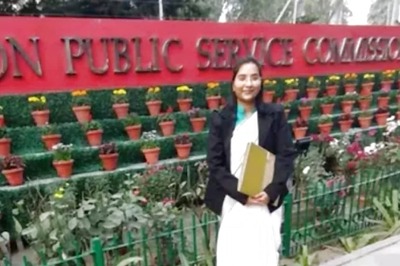
views
Muslims after Independence emerged as the base vote for the Congress. They used to get political representation under the ruling Congress, in the party as well as in the government. The community was receiving its share silently until 1960s after which Muslims became assertive. They demanded their share in power and developmental opportunities which created pressure on the Congress. To satisfy the growing desires of the Muslim community, the Congress evolved an ‘extra caring gesture’, largely symbolic and at times substantial, which led to the rise of what is now known as ‘appeasement politics’. Although the argument against Muslim appeasement first emerged in pre-colonial times through Hindutva discourse but it acquired more visibility during 1960s and through the politics of the Congress.
It is interesting to observe that Muslims are perceived as a homogeneous vote bank who cast vote en bloc and vote strategically to defeat the BJP. This perception may be partially true but it overlooks the inherent heterogeneity of the community. Muslims as a religious community are divided in various sub-groups, and based on identity, they can be placed under three categories, Ashraf, Azlaf and Arzal.
The Ashrafs comprise Sayyid, Sheikh, Mughal and Pathans. The non-Ashrafs are categorised as Azlaf; they primarily include Sheikh, Churihar, Dai, Dhawa, Dhunia, Gaddi, Kalal, Kasai, Kula Kunjara, Laheri, Mahifarosh, Mallah, Naliya, Nikari, Abdal, Bako, Bediya, Bhal, Chamba, Dafali, Dhobi, Hajjam, Mucho, Nagarchi, Nal, Panwaria, Madaria, Tunlia. The Arzals consist of communities such as Bhanar, Halalkhor, Hijra, Kasbi, Lalbegi, Maugta, Mehtar. In spite of these internal divisions, the Muslim community is usually divided into Shias and Sunnis and a large number of Shias have been voting for the BJP since decades. These internal divisions among Muslims may have been reflected in their political mobilisation too. But this possible heterogeneity in their political attitude has not got enough attention in the studies and analyses by journalists and political analysts.
ALSO READ | UP Next: OBCs Hold the Key to the Success of BJP’s Mission 2022
The decade of 90s brought a sea change in the nature of mobilisation of Muslims not only in Uttar Pradesh but all over India. The Ram Janmabhoomi-Babri Mosque issue that emerged during the 90s led to two changes. On one hand, it brought cohesive political assertion among the Muslim community and, on the other hand, the impact of the implementation of the Mandal commission also reshaped political aspirations of a section of Muslims. This led to the emergence of political leadership among Azlaf and Arzal sections. Due to the intense Mandal discourse, the Muslim community understood the dominance of Ashrafs in politics. But it could not attack the Ashraf structure of community politics in aggressive ways, but slowly and steadily a political consciousness developed among Azlafs and they started creating their own leadership.
If someone prepares a political map of Muslim mobilisation, they may understand that due to various reasons Muslims deserted the Congress in Uttar Pradesh and moved towards parties such as the Samajwadi Party and the Bahujan Samaj Party who were claiming to fight for social justice. The leaders from various Azlaf communities joined the politics of the SP and the BSP in the late 90s. The Pasmanda Movement which also emerged a few decades ago had triggered a political consciousness among backward Arzal communities. So, the traditional Muslim leadership, which was mostly dominated by Ashrafs, started getting replaced by Azlafs and Arzals in various ways. Secularism combined with the aspiration of social justice, which was earlier the Congress’s plank, was now identified with the SP and the BSP, which attracted Muslims. The BJP as a Hindutva party also worked towards counter mobilisations of Muslims, which went in favour of parties that were doing politics around Mandal Commission-produced slogans of social justice.
A drastic change appeared in the politics around Muslims when the BJP almost ruptured the perception of a homogeneous Muslim vote bank that can influence a party’s victory or defeat by their political shifting. The BJP in the 2014 elections proved that if broader Hindu mobilisation emerges in the favour of the party, there is no need to run behind Muslim votes. The BJP also proved that there is no need for appeasement politics to bring Muslims under the domain of development, alongside other communities. So, the BJP brought two notable changes in the post-2014 politics: It challenged the overestimation of Muslim votes, and proved that there is no need for any appeasement politics for electoral victory in a democracy. It does not mean that the opposition in Uttar Pradesh will stop practising their conventional methods of Muslim mobilisation. It is true that the aggressive rise of the BJP’s politics has made them a bit defensive about their appeasement politics, and have prompted them to project their soft Hindutva image, but these parties are still heavily dependent on their conventional political methods, which has evolved from the argument of secularism.
We need to see whether or not Muslims behave as a cohesive homogeneous vote bank. One needs to observe if a section of poor and downtrodden Muslims will move towards the BJP due to developmental schemes such as Pradhan Mantri Awas Yojana, Ujjawala Yojana and several other cash transfer benefits. Last but not the least, whether Muslims will respond as an identity-craving community or as development-aspiring people in the UP assembly 2022 elections.
(The views expressed in this article are those of the author and do not represent the stand of this publication.)
Read all the Latest News, Breaking News and Assembly Elections Live Updates here.















Comments
0 comment